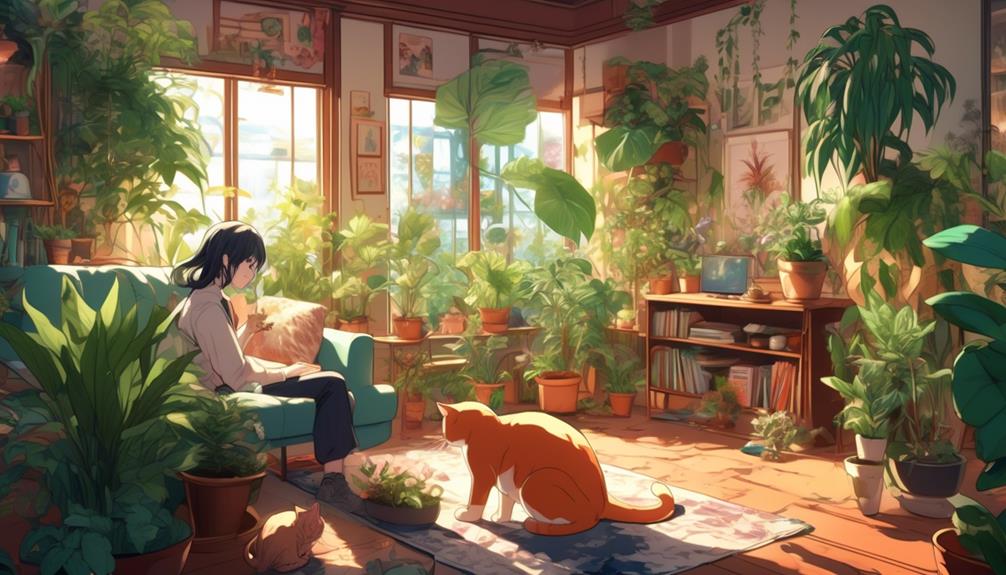How To Become More Self-Sufficient Without Starting a Full-Blown Farm…
Want to start preserving your harvest, making your own soap, or building a backyard root cellar — but not sure where to begin? “Homesteading Advice” gives you instant lifetime access to 35+ practical homesteading books on food preservation, veggie gardening, DIY natural cleaning products (save over $250 per year with this skill alone), brewing, off-grid energy, and a whole lot more…
Click Here To Check It Out Now!
If you’re a cat owner, you know how important it is to create a safe environment for your furry friend. As you decorate your home with houseplants, it’s crucial to be aware that some of them can be toxic to cats. From elegant lilies to trendy Monstera Deliciosa, there are several common houseplants that pose a potential danger.
But which ones exactly? Well, you’ll be surprised to discover the list of plants that could potentially harm your beloved feline. So, before you bring any greenery into your home, let’s explore these common houseplants that are toxic to cats and find out how to keep your cat safe.
Plants Toxic To Cats…
- True lilies, such as Easter lilies and Asiatic lilies, are extremely toxic to cats and can cause fatal kidney failure.
- Peace Lily and Aloe Vera can also be toxic to cats if ingested, leading to symptoms like vomiting, diarrhea, and kidney failure in severe cases.
- Cutleaf Philodendron and Pothos contain insoluble calcium oxalates that can cause oral irritation and gastrointestinal tract irritation in cats.
- Jade Plant, Snake Plant, and Sago Palm are all toxic to cats and can cause various symptoms, including vomiting, diarrhea, and liver failure in the case of sago palm ingestion. Immediate veterinary care is crucial in these cases.
Lilies
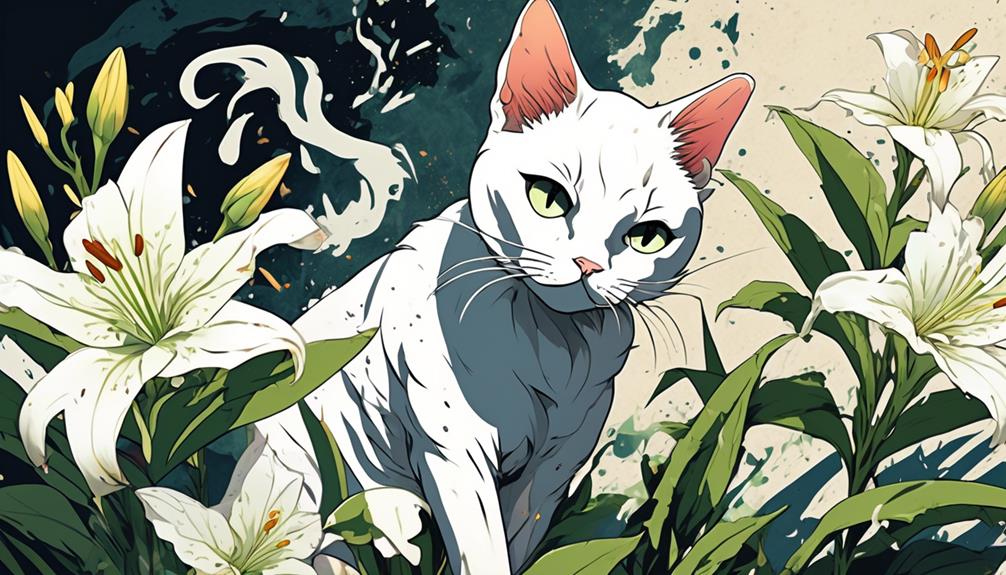
Lilies pose a significant threat to the health and well-being of cats due to their extreme toxicity. True lilies, such as Easter lilies and Asiatic lilies, are particularly dangerous and can cause kidney failure if ingested.
It’s important to note that all parts of the lily plant are toxic to cats, including the flowers, stems, leaves, and even the pollen. Ingestion of even the smallest amount of true lilies can be fatal and may lead to severe kidney failure in cats.
When a cat ingests lilies, it can experience a range of symptoms, including vomiting, diarrhea, and oral irritation. These symptoms are primarily caused by the presence of calcium oxalates in the plant. Additionally, benign lilies like Peruvian, peace, and calla lilies may cause minor symptoms such as mouth irritation and drooling in cats.
If you suspect that your cat has ingested any part of a lily plant, it’s crucial to seek emergency medical care immediately. Prompt action can be life-saving for your feline companion. Remember, prevention is key when it comes to protecting your cat from toxic plants like lilies. Keep these plants out of your home and garden, ensuring a safe environment for your beloved pet.
‘Did You Know? Lilies have been cultivated for thousands of years and have symbolic meanings in various cultures. In ancient Greece, lilies were associated with the goddess Hera and were a symbol of purity and devotion. In Christian art, lilies are often depicted as a symbol of the Virgin Mary’s purity and innocence. Despite their beauty and cultural significance, it’s important to remember that lilies can be extremely dangerous for our feline friends.’
Peace Lily
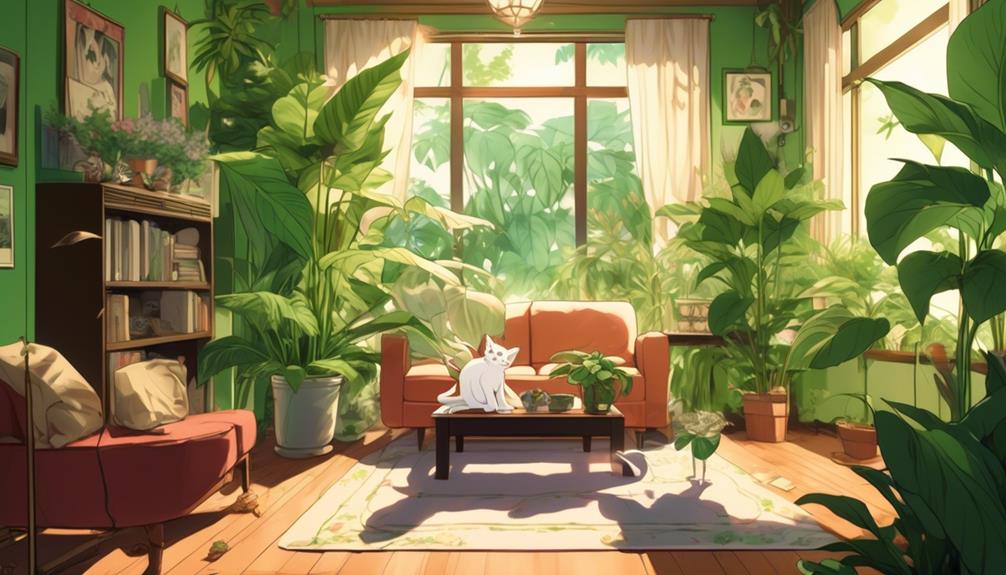
Peace Lily, also known as Spathiphyllum, is a common houseplant that can be toxic to cats. The toxicity of this plant is due to the presence of insoluble calcium oxalates.
While Peace Lily isn’t a true lily, it can still cause harmful effects if ingested by cats.
If a cat ingests any part of the Peace Lily, such as the leaves, it can experience a range of symptoms. These symptoms may include vomiting, diarrhea, and oral pain. The insoluble calcium oxalates in the plant can cause irritation and discomfort in the mouth and throat of the cat.
In more severe cases, ingestion of Peace Lily can lead to kidney failure in cats. This is a serious condition that can be life-threatening if not treated promptly. If you suspect that your cat has ingested any part of a Peace Lily, it’s important to seek veterinary attention immediately.
To prevent accidental ingestion, it’s recommended to keep Peace Lily plants out of reach of cats. This can help ensure the safety and well-being of your feline companion. It’s always better to be cautious when it comes to toxic plants and the health of your cat.
‘Did you know? Peace Lilies aren’t only toxic to cats, but they can also be harmful to dogs and humans if ingested. It’s important to be aware of the potential dangers of this popular houseplant and take necessary precautions to keep all members of your household safe.’
Aloe Vera
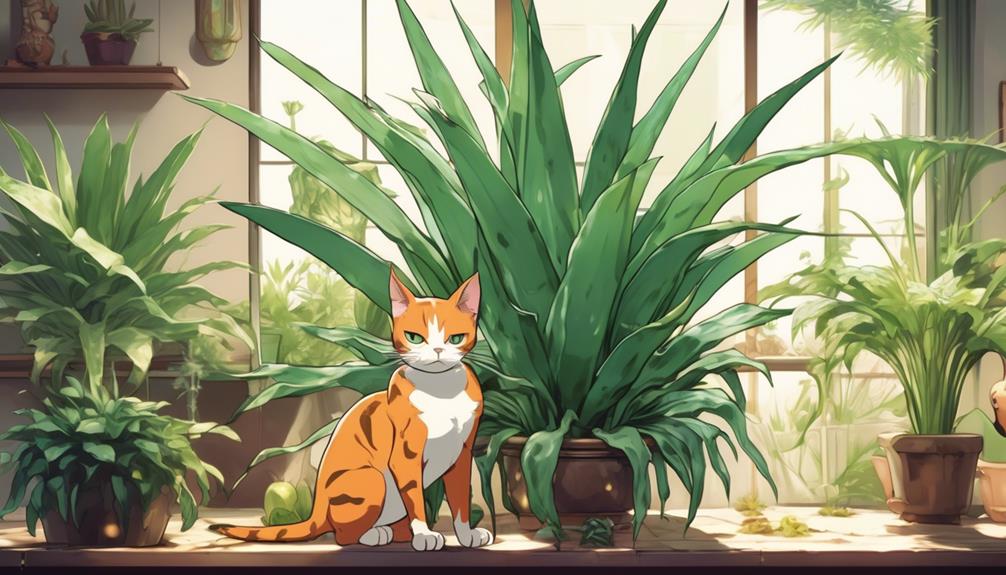
Aloe Vera, a popular succulent with recognizable succulent-like leaves, can be toxic to cats if ingested due to the presence of saponins and anthraquinone. While Aloe Vera is known for its numerous health benefits for humans, it can cause harm to our feline companions.
If a cat ingests Aloe Vera, it can lead to gastrointestinal signs such as vomiting and diarrhea. These symptoms typically appear within a few hours of ingestion. The toxic components of Aloe Vera, saponins and anthraquinone, can cause irritation in the oral cavity and stomach, leading to discomfort and potential damage to the gastrointestinal tract.
It’s important to note that not all parts of the Aloe Vera plant are toxic to cats. The leaves and pulp are the parts that contain the harmful substances. Therefore, if you have Aloe Vera in your home, it’s crucial to keep it out of your cat’s reach.
If you suspect that your cat has ingested Aloe Vera or any other toxic plants, it’s recommended to contact your veterinarian immediately for proper guidance and treatment. Remember, the well-being of your feline friend is of utmost importance, so be cautious with the presence of toxic plants like Aloe Vera.
‘Did you know? Aloe Vera has been used for medicinal purposes for over 6,000 years, dating back to ancient Egypt and Mesopotamia. It was believed to have healing properties for various ailments, including skin conditions and digestive issues.’
Cutleaf Philodendron
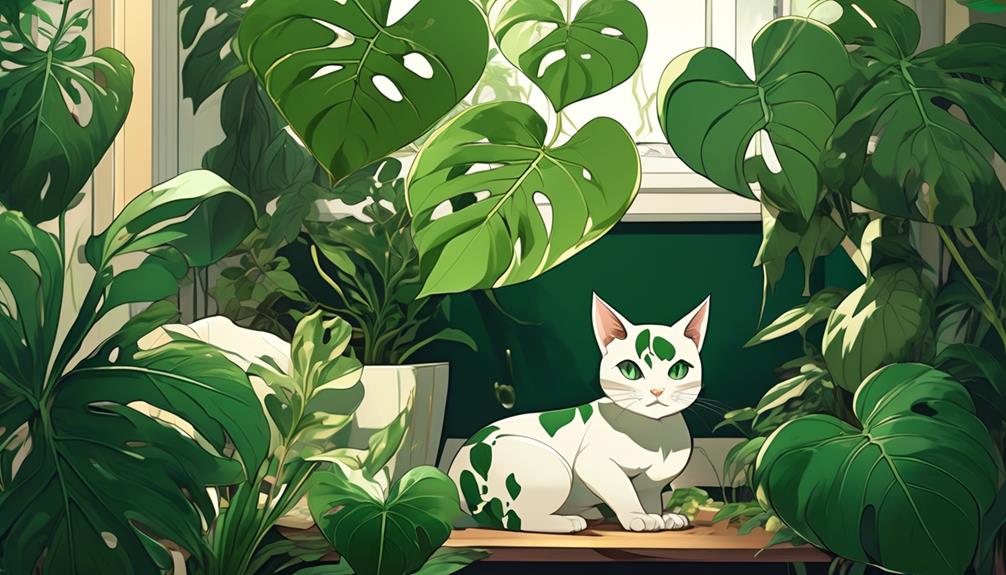
Cutleaf Philodendron, also known as Monstera Deliciosa, is a popular tropical houseplant with stunning foliage that can pose a serious threat to your cat’s health if ingested. Here are three important facts about this toxic plant:
- Insoluble calcium oxalates: Cutleaf Philodendron contains insoluble calcium oxalates, which can cause oral irritation, burning, and excessive drooling in cats. These oxalate crystals can also lead to gastrointestinal tract irritation when ingested in large quantities. Symptoms may include vomiting, abdominal pain, diarrhea, and loss of appetite.
- Toxicity to cats and dogs: Cutleaf Philodendron is toxic to both cats and dogs. If you suspect that your cat has ingested any part of this plant, it’s crucial to seek immediate veterinary care. Contact your veterinarian or the poison control center for guidance on how to proceed.
- Potentially toxic compounds: Cutleaf Philodendron contains other potentially toxic compounds such as saponins and alkaloids. These substances can affect the nervous system, leading to abnormal heart rhythms and other serious health issues.
To ensure your cat’s safety, it’s best to keep this plant out of their reach. If you have this plant in your home, consider placing it in an area where your cat can’t access it. Remember, prevention is the key to protecting your feline friend from the harmful effects of Cutleaf Philodendron.
‘Did you know? The Monstera Deliciosa plant is native to the rainforests of Central and South America. Its unique leaf structure, with its characteristic holes, is thought to have evolved to allow more sunlight to reach the lower parts of the plant in its natural habitat.’
Pothos
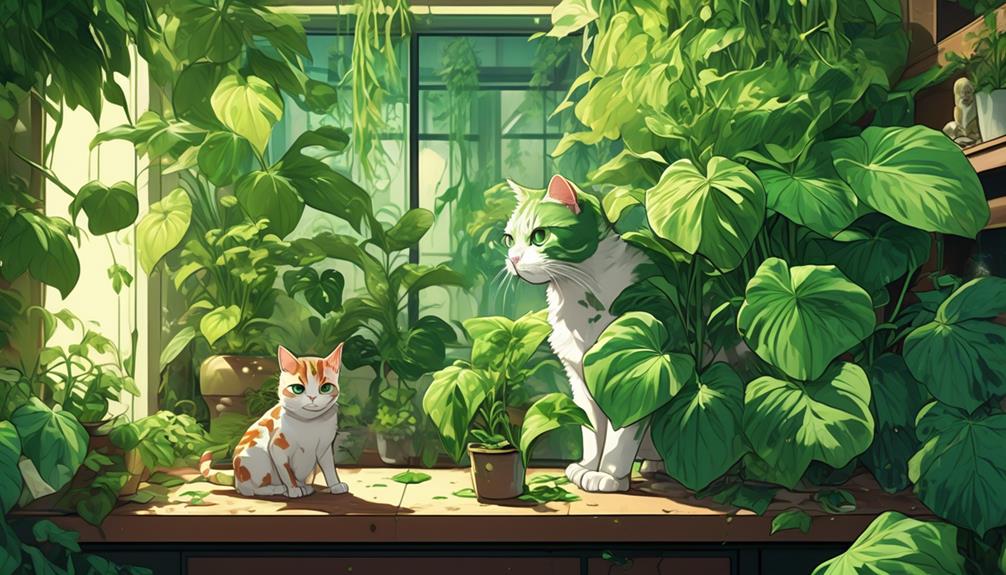
Pothos, scientifically known as Epipremnum aureum, is a popular houseplant with heart-shaped leaves that can be toxic to cats if ingested. The entire plant is toxic and contains insoluble calcium oxalates, which can cause oral irritation and burning when consumed by cats.
Ingesting Pothos may lead to symptoms such as vomiting, drooling, and difficulty swallowing. It’s essential to be cautious when having this plant in a home with cats to prevent accidental ingestion.
| Fact | Description |
|---|---|
| Toxicity | Pothos is toxic to cats if ingested. |
| Insoluble Calcium Oxalates | The plant contains insoluble calcium oxalates, which can cause oral irritation and burning. |
| Symptoms | Ingesting Pothos may result in vomiting, drooling, and difficulty swallowing. |
| Veterinary Care | If your cat ingests Pothos, seek immediate veterinary care and follow the vet’s instructions. |
| Prevention | To ensure your cat’s safety, consider using alternative non-toxic plants in your home. |
It’s important to prioritize your cat’s well-being and take steps to prevent any potential harm. By being aware of the toxicity of Pothos and other toxic plants, you can create a safe environment for your feline companion.
Jade Plants
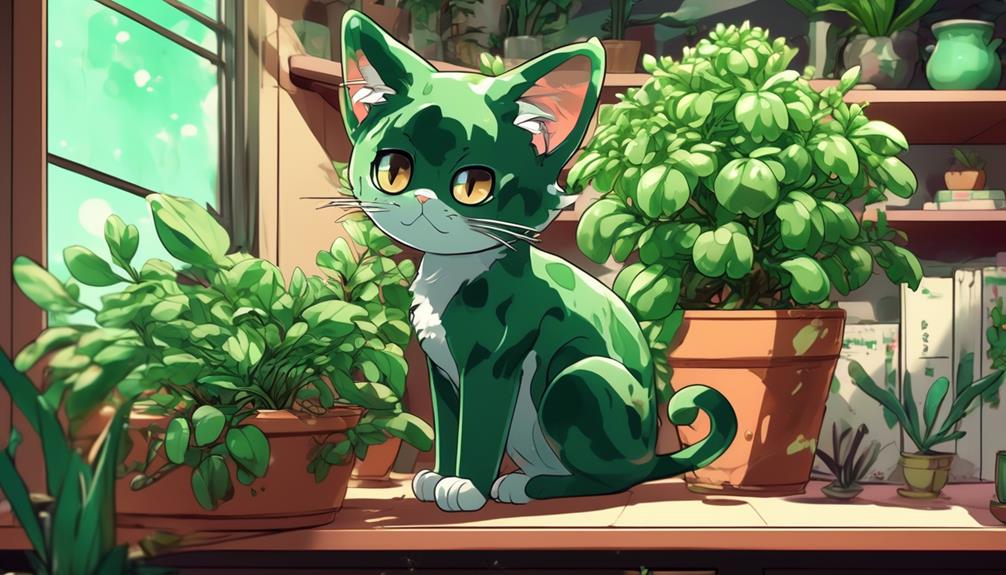
Jade Plants, also known as money plants or dollar plants, are known for their toxic properties to cats, dogs, and horses. These popular plants contain toxic compounds that can cause harm if a cat has ingested them.
Here are three important facts about jade plant toxicity in cats:
- All parts of the jade plant are toxic to cats. The leaves, stems, flowers, and even the sap contain substances that can be harmful to our feline friends.
- Symptoms of jade plant toxicity in cats can range from mild to severe. If a cat has ingested this plant, they may experience vomiting, diarrhea, depression, and incoordination. These symptoms can vary depending on the amount of plant material ingested and the individual cat’s sensitivity.
- The toxic compounds found in jade plants are known as cardiac glycosides. These compounds can affect the heart and other organs, leading to difficulty breathing, abnormal heart rhythms, and even cardiac arrest in severe cases.
To keep your cat safe, it’s important to keep jade plants out of their reach. If you suspect your cat has ingested any part of a jade plant, seek veterinary care immediately.
‘Did You Know? Jade plants aren’t only toxic to cats but can also be harmful to humans if ingested in large quantities? It’s always best to exercise caution and keep these plants away from curious mouths, whether they belong to our feline friends or ourselves.’
Snake Plant

Snake Plants, also known as Dracaena trifasciata, are a common houseplant that can be toxic to cats if ingested. These plants contain insoluble calcium oxalates, which can cause mild to severe toxicity in cats.
The milky sap found in Snake Plants contains these oxalates, which can cause intense burning and irritation if it comes into contact with the mouth and stomach of a cat. Symptoms of ingestion may include vomiting, excessive drooling, and gastrointestinal upset.
It is important to note that Snake Plants aren’t the only plants that can be toxic to cats. Other common houseplants such as Daffodils and Lilies (Lilium or Hemerocallis) can also be toxic for cats if consumed in large quantities. Additionally, certain types of Ivy (Hedera) and the flowering plant Water Hyacinths can cause mild toxicity in cats.
If you have a curious cat and have Snake Plants or other potentially toxic plants in your home, it’s important to keep them out of reach. If you suspect that your cat has ingested a toxic plant, it’s recommended to contact the ASPCA Animal Poison Control or your veterinarian immediately for guidance. Prompt action can help ensure the well-being and safety of your feline companion.
Sago Palm

If you have already addressed the dangers of Snake Plants, it’s important to now turn your attention to the highly toxic Sago Palm. Here are three important facts you need to know about the dangers of Sago Palm for your feline companions:
- Toxic Effects: Sago Palm is highly toxic to cats. Ingesting any part of this plant can lead to severe consequences for your beloved pet. The sago palm contains a toxic property called cycasin, which can cause vomiting, bloody stool, jaundice, increased thirst, excessive drooling, and even liver failure.
- Rapid Onset of Symptoms: If your cat ingests any part of the sago palm, symptoms can manifest within 15 minutes to a few hours. It’s vital to act swiftly if you suspect your cat has ingested this plant. Delay in seeking medical attention can have dire consequences for your feline friend.
- Seek Emergency Veterinary Care: If you notice any signs of sago palm ingestion, such as vomiting or excessive drooling, it’s crucial to seek immediate emergency veterinary care. The survival rate with aggressive treatment is approximately 50%, highlighting the severity of this plant’s toxic effects.
Keeping Kitty Safe…
It’s crucial to be aware of the potential dangers that certain common houseplants pose to our feline companions. True lilies, such as Easter lilies and Asiatic lilies, can be likened to ticking time bombs for cats, as ingestion can lead to kidney failure.
Additionally, other toxic plants like peace lilies, Aloe Vera, and Pothos should be kept out of their reach. Remember, just as a single drop of poison can have devastating effects, so too can these toxic plants on our beloved cats’ health.
